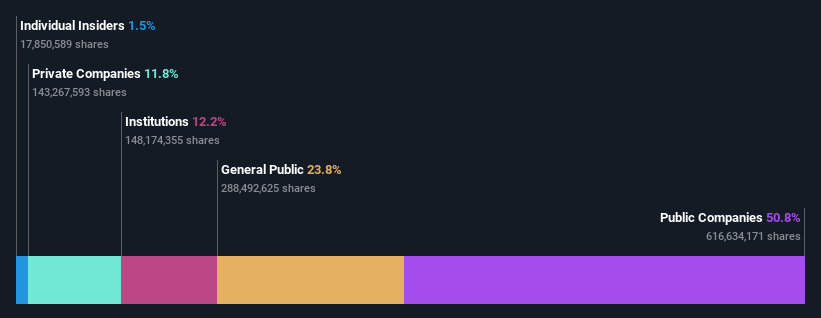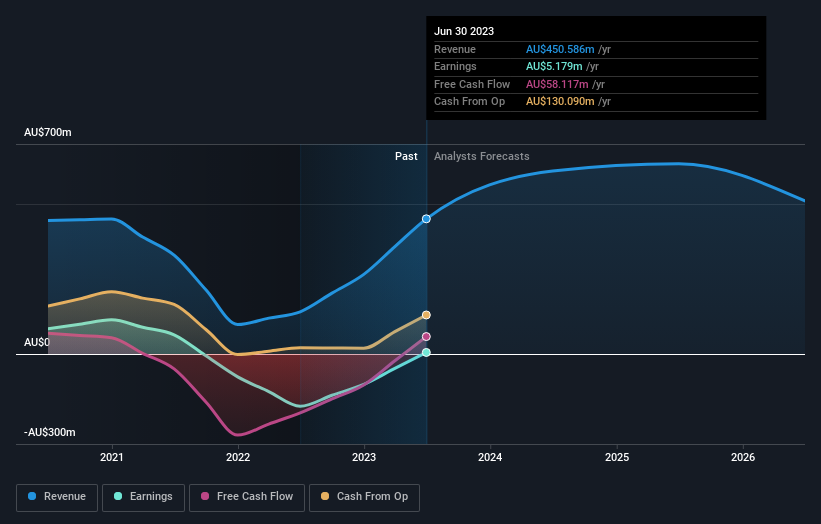Mount Gibson Iron Limited's (ASX:MGX) top owners are public companies with 51% stake, while 24% is held by individual investors
Key Insights
The considerable ownership by public companies in Mount Gibson Iron indicates that they collectively have a greater say in management and business strategy
The top 3 shareholders own 59% of the company
If you want to know who really controls Mount Gibson Iron Limited (ASX:MGX), then you'll have to look at the makeup of its share registry. The group holding the most number of shares in the company, around 51% to be precise, is public companies. In other words, the group stands to gain the most (or lose the most) from their investment into the company.
And individual investors on the other hand have a 24% ownership in the company.
Let's delve deeper into each type of owner of Mount Gibson Iron, beginning with the chart below.
View our latest analysis for Mount Gibson Iron
What Does The Institutional Ownership Tell Us About Mount Gibson Iron?
Institutional investors commonly compare their own returns to the returns of a commonly followed index. So they generally do consider buying larger companies that are included in the relevant benchmark index.
Mount Gibson Iron already has institutions on the share registry. Indeed, they own a respectable stake in the company. This can indicate that the company has a certain degree of credibility in the investment community. However, it is best to be wary of relying on the supposed validation that comes with institutional investors. They too, get it wrong sometimes. If multiple institutions change their view on a stock at the same time, you could see the share price drop fast. It's therefore worth looking at Mount Gibson Iron's earnings history below. Of course, the future is what really matters.
Mount Gibson Iron is not owned by hedge funds. Looking at our data, we can see that the largest shareholder is APAC Resources Limited with 37% of shares outstanding. In comparison, the second and third largest shareholders hold about 13% and 9.4% of the stock.
To make our study more interesting, we found that the top 3 shareholders have a majority ownership in the company, meaning that they are powerful enough to influence the decisions of the company.
While studying institutional ownership for a company can add value to your research, it is also a good practice to research analyst recommendations to get a deeper understand of a stock's expected performance. There is some analyst coverage of the stock, but it could still become more well known, with time.
Insider Ownership Of Mount Gibson Iron
The definition of company insiders can be subjective and does vary between jurisdictions. Our data reflects individual insiders, capturing board members at the very least. The company management answer to the board and the latter should represent the interests of shareholders. Notably, sometimes top-level managers are on the board themselves.
Most consider insider ownership a positive because it can indicate the board is well aligned with other shareholders. However, on some occasions too much power is concentrated within this group.
We can see that insiders own shares in Mount Gibson Iron Limited. It has a market capitalization of just AU$668m, and insiders have AU$9.8m worth of shares, in their own names. It is good to see some investment by insiders, but it might be worth checking if those insiders have been buying.
General Public Ownership
The general public, who are usually individual investors, hold a 24% stake in Mount Gibson Iron. While this size of ownership may not be enough to sway a policy decision in their favour, they can still make a collective impact on company policies.
Private Company Ownership
It seems that Private Companies own 12%, of the Mount Gibson Iron stock. Private companies may be related parties. Sometimes insiders have an interest in a public company through a holding in a private company, rather than in their own capacity as an individual. While it's hard to draw any broad stroke conclusions, it is worth noting as an area for further research.
Public Company Ownership
It appears to us that public companies own 51% of Mount Gibson Iron. It's hard to say for sure but this suggests they have entwined business interests. This might be a strategic stake, so it's worth watching this space for changes in ownership.
Next Steps:
I find it very interesting to look at who exactly owns a company. But to truly gain insight, we need to consider other information, too.
I always like to check for a history of revenue growth. You can too, by accessing this free chart of historic revenue and earnings in this detailed graph.
If you would prefer discover what analysts are predicting in terms of future growth, do not miss this free report on analyst forecasts.
NB: Figures in this article are calculated using data from the last twelve months, which refer to the 12-month period ending on the last date of the month the financial statement is dated. This may not be consistent with full year annual report figures.
Have feedback on this article? Concerned about the content? Get in touch with us directly. Alternatively, email editorial-team (at) simplywallst.com.
This article by Simply Wall St is general in nature. We provide commentary based on historical data and analyst forecasts only using an unbiased methodology and our articles are not intended to be financial advice. It does not constitute a recommendation to buy or sell any stock, and does not take account of your objectives, or your financial situation. We aim to bring you long-term focused analysis driven by fundamental data. Note that our analysis may not factor in the latest price-sensitive company announcements or qualitative material. Simply Wall St has no position in any stocks mentioned.


